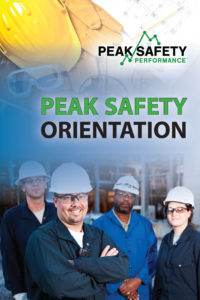Peak Safety Training Calendar
2024 Training Schedule
| Class Title | Class Date | Location | Class Length | Registration Deadline | Cost | Register |
|---|---|---|---|---|---|---|
| Lunch and Learn | ICAR Campus One Research Drive 3rd Floor Conference Room | 1 Hour | $0 | Register HERE | ||
| Put Safety Principles into Practice | ICAR Campus One Research Drive 3rd Floor Conference Room | 8:00 - 4:00 | $395 | Register HERE |
OSHA COMPLIANCE CLASSES
The Peak Safety Orientation
This is a hazard identification safety training class designed to provide critical safety information for new employees. Instructors teach basic OSHA guidelines covered in both 1910 & 1926 standards.
The Peak Safety Orientation is full day class.  Each participant will also receive a Peak Safety Orientation Handbook with critical safety rules and guidelines. The handbook provides a quick reference to the same topics covered in the class. Samples are available for purchase on Amazon.
Each participant will also receive a Peak Safety Orientation Handbook with critical safety rules and guidelines. The handbook provides a quick reference to the same topics covered in the class. Samples are available for purchase on Amazon.
OSHA 10/30
 The 10 & 30 Hour OSHA Outreach Training Program is intended to provide a variety of training to workers with some safety responsibility. The course focus is on what is required in the OSHA standards as well information about who OSHA is and how they operate. The Training also emphasizes hazard identification, avoidance, control and prevention. Instructional time must be a minimum of 10 hours. OSHA also requires that the class instructional time is spread over two days for not more than 7.5 hours in one day.
The 10 & 30 Hour OSHA Outreach Training Program is intended to provide a variety of training to workers with some safety responsibility. The course focus is on what is required in the OSHA standards as well information about who OSHA is and how they operate. The Training also emphasizes hazard identification, avoidance, control and prevention. Instructional time must be a minimum of 10 hours. OSHA also requires that the class instructional time is spread over two days for not more than 7.5 hours in one day.
Silica Competent Person Training
This course presents an overview of the dangers of silica. The course covers safe work procedures where workers are exposed to silica. The focus of this course is to familiarize you with practices that decrease the risk of exposure, and to offer best practices for mitigating the dangers of exposure to silica in construction.
Competent Person Fall Protection
This training provides a classroom presentation & practical demonstration. The material will help participants that have to provide fall protection solutions. The class is intended to provide a full range of requirements and considerations for working at heights. Working at heights duties may include working on a roof, from a ladder, in an aerial lift, or on other facility or equipment structures. The concepts in this class are applicable to industrial, commercial, and construction work locations.
Basics of 70E Arc Flash
This class is focused on the basics of Electrical Arc Flash and the surrounding Electrical Hazards when working around industrial power installations and operational environments. The course utilizes the guidelines and work rule requirements outlined from the NFPA 70E and OSHA to emphasize the safety precautions that must be adhered to when dealing with Arc Flash Hazards.
Basics Rigging
The Half Day Basic Rigging & Inspection Course is designed to provide participants with a basic level of knowledge of rigging gear inspection, proper rigging procedures, and load control using typical rigging techniques. The course is based on applicable OSHA standards and industry best practices.
SAFETY LEADERSHIP CLASSES
CONTEXT; Root Cause Analysis
 CONTEXT is a Root Cause Analysis class that takes a tactical approach to identifying the root cause in an incident. The class will review basic investigation principles that will help participants learn to understand the context of the event.
CONTEXT is a Root Cause Analysis class that takes a tactical approach to identifying the root cause in an incident. The class will review basic investigation principles that will help participants learn to understand the context of the event.
In this session, the participants will learn different approaches for analyzing events and collecting information that that lead to an incident. The analysis tool prompts an investigator to evaluate the conditions and behaviors that contribute to the incident in a systematic process. The process provides data that you can trend and identify causes as well as specific defense failures.
Safety Leadership Training – Supervisors
 We have a safety leadership workshop that will help your supervisors manage safety. We customize the packages to meet every client’s needs.
We have a safety leadership workshop that will help your supervisors manage safety. We customize the packages to meet every client’s needs.
It is important to teach supervisors the skills required to lead safety. This training is a collection of topics that share why safety is important. Modules also communicate safety roles and responsibilities along with practical tools a supervisor can use to lead safety efforts with their teams.
At the end of the course, participants will better understand their personal impact on safety performance. The class will also provide practical examples of tools and techniques they can use to prevent injuries.
Risk Perception; Why do we take chances?
Our Risk Perception course introduces participants to safety leadership tools that can be used to help minimize risk and avoid errors. This simple approach will help clients build a successful safety culture.
Everyone perceives and accepts risk in a different way. The dynamics of how we make decisions is complex and our ability to perceive danger is one of the first steps to prevent injuries. What is the right level of risk perception and better yet, how do you teach people to recognize and respect hazards?
The goal for the Risk Perception Workshop is to teach participants how to make their biggest impact on safety performance with risk perception safety leadership tools and techniques.